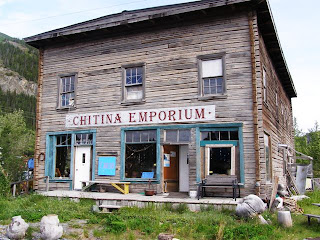Rich in history, Chitina is nestled at the edge of the Wrangell-St. Elias National Park, surrounded by spectacular mountains and roaring rivers.
Chitina began in the early 1900's as supply town for the Kennicott Mine and Copper River Northwestern Railway. When copper prices began to decline, Chitina became a ghost town.
Chitina is located on the edge of Wrangell-St. Elias National Park, the largest, most pristine of our National Parks. History comes to life as you travel back in time to the boom days of copper mining and gold rushes. Spend a few days in the Alaska you have envisioned. You will find the area accessible but not yet over developed. Alaskans sharing Alaska and making your visit a memorable experience that you will cherish for years.

Chitina sprang up with a boom from 1908 to 1915. It once boasted that it had the finest accommodations north of Seattle...Breedman’s Hotel Chitina. It was a transportation “hub” connecting the Kennicott copper mine with Seattle smelters via train from Kennicott to Cordova; then barge to Seattle. It also connected to Fairbanks via road. The railroad arrived in 1910 and Chitina thrived until 1938 when the railroad pulled out. It quickly became a ghost town, and eventually even had ‘ghosts’ painted on several of the abandoned buildings. Work is currently underway to have Chitina declared a historical district. It is a treasure trove of old buildings, cars, and stories.
Chitina is at the confluence of the Copper and Chitina Rivers. It is a hot spot for Alaskan dip-net fishing for the world re-known Copper River Red Salmon. It is also the gateway to Wrangell-St. Elias National Park which contains five of the ten largest peaks on the North American Continent. The pavement ends at Chitina and the road into the park is gravel and a slow drive; so many choose to overnight in Chitina.
...

No comments:
Post a Comment